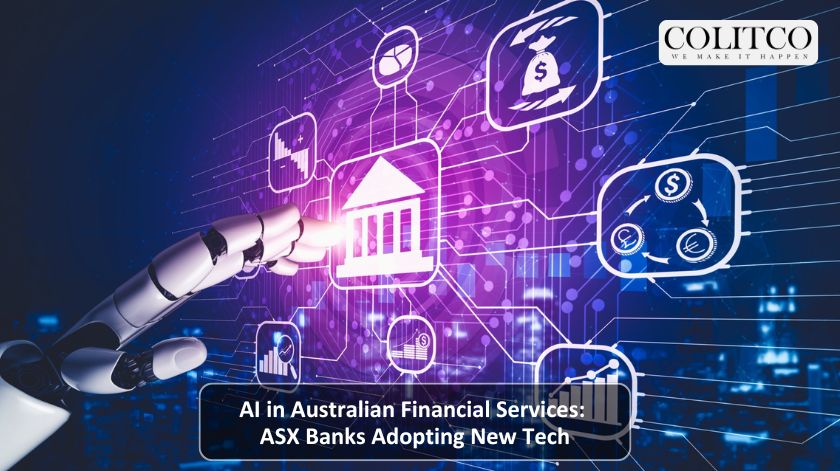Artificial intelligence (AI) is transforming the Australian banking industry, and ASX-listed banking companies are implementing sophisticated applications to ensure compliance, optimise customer services, and internal operations.
Banks are utilising machine learning and automation to boost their efficiency and overcome workforce, regulatory, and reputational challenges, from fraud prevention to conversational AI. The use of AI has ceased to be experimental and has taken centre stage as a strategy for competing banks in a data-driven environment.
AI Moves at Major Banks
Major financial institutions in Australia are incorporating AI into their operations. The Commonwealth Bank has been determined to integrate AI in its customer-facing services and internal operational systems in strategic technology relationships. This is done to enhance operations resilience and fast-track the introduction of innovative financial products.

ASX-listed banks like Commonwealth Bank and ANZ integrate AI into customer service and operations.
Meanwhile, the bank has also been questioned about the effects of AI on employment. The bank reversed the decision after announcing the reduction of customer service jobs due to the introduction of AI-driven chatbots, but both employees and unions mocked it. The turnabout highlighted the fine line that exists between innovation and the social responsibility to protect jobs.
ANZ Bank, too, has been reorganising its operations in a more technology-oriented way. The bank has strengthened its online banking department and invested in AI-based operations to detect fraud and enhance customer interactions. In addition to modernising activities, major layoffs in the workforce have also been announced, which indicates the way the digital transformation is altering the traditional banking structures.
Artificial Intelligence in Fraud Prevention and Compliance
Compliance and fraud prevention are among the best arguments in favour of AI implementation in the financial services industry. Banks process millions of transactions daily, and the application of AI solutions enables the real-time identification of unusual behaviour that may be a scam or fraud.
Big banks now have artificial intelligence tools capable of automatically detecting and preventing suspicious transactions, and notifying customers within seconds. Banks are also incorporating features like digital kill switches into their banking applications, which give clients the ability to turn their accounts off immediately after they detect any unauthorised access to their accounts. Such AI-powered inventions are transforming the way banks protect customer confidence and reduce financial losses.
But regulators are wary. As AI has grown in sensitive risk areas like compliance, accountability, model transparency, and bias have become a source of concern. Governance systems must evolve with the increasing complexity of AI models, ensuring that machine decisions are just, explainable, and lawful.
Automation and Customer Service
The way banks interact with their customers is also changing due to the advent of AI. Chatbots and virtual assistants can now handle thousands of queries every week, including transaction details, and support for small businesses. These systems enable human agents to focus on more complex cases, thereby enhancing efficiency at each service centre.
To banks, automation would save a lot of money. But its rapid uptake has caused workforce issues. Staff members have also complained about training artificial intelligence (AI), which may one day replace them. There were instances where employees discovered that their efforts were being leveraged to develop AI agents that could potentially replace their jobs. Herein lies the human aspect of automation and the necessity of reskilling programs to support staff in their transition.

AI chatbots streamline banking services but raise questions about workforce reskilling and job security.
Regardless of the controversy, AI-based customer engagement is emerging as a central corporate strategy of financial institutions. Generative AI agents are being utilised more to individualise communication, anticipate customer requirements, and offer financial guidance at scale. This change is a symptom of the transformation of customer relationships in banking due to the influence of data-driven decision-making.
Technology Infrastructure and Productivity
ASX-listed banks are changing their infrastructure to support the large-scale adoption of AI. The priorities are cloud migration, secure data management, and inner AI pipelines so that scalable systems can be created. Investments are also being made in AI training for personnel, enabling the technology to be used responsibly and efficiently.

ASX-listed banks invest in secure cloud infrastructure and AI systems to boost long-term productivity.
The potential productivity of AI has been shown to work in experiments in technical teams. The use of coding assistants and automated tools has been shown to benefit engineering departments by introducing efficiency in the workflow. Despite security and quality control concerns, the benefits of a rapid development pace and decision support are bearing fruit in the long term for banks that strive to stay ahead of international competition.
Risks and Challenges
Implementing AI in banking does not come easy. Key risks include:
- Job displacement: Some banks have already had their support staff displaced by automation, leading to a backlash and demands for stronger workforce safeguards.
- Algorithmic bias: Artificial intelligence can be used by default against some groups of customers, which can lead to a sense of unfairness and even ethical dilemmas.
- Data security: The stakes are large in terms of financial data, which means there is a strong necessity to safeguard against breaches and abuse.
- Regulatory loopholes: The existing regulatory systems may not be sufficient to handle the intricacies of AI systems, and there may be opportunities to claim liability.
- Customer trust: Negative media coverage of job losses caused by AI or unclear decision-making may lead to a reduction in trust among users.
These dilemmas underscore the necessity of effective governance, transparency, and human control to strike a balance between innovation and stability.
Financial Markets and Commodities.
In addition to conventional banking, AI applications in the financial industry have repercussions on commodity investors and global markets. Improved currency forecasting, fraud prevention and compliance systems indirectly affect capital flows and investor confidence. Responsibly harnessed AI by banks can help them lower operational expenses, reduce exposure to risk, and increase long-term profitability.
In the case of Australia, a nation closely tied to commodity exports and global capital, the implementation of AI by ASX banks helps the country remain competitive. With predictive analytics and enhanced data processing, banks can offer investors more precise and efficient insights, ultimately leading to more effective hedging strategies.
Also Read: AI-Powered Commodities Trading: How Machine Learning is Shaping Metal Futures Markets
Final Thoughts
The fact that AI is becoming increasingly prominent in Australian financial services is indicative of the movement towards data-driven decision-making and operations. Banks listed on the ASX lead this change and utilise AI to enhance compliance, combat fraud, and improve customer services.
Although the opportunities are vast, the risks are equally substantial. Some of the challenges that cannot be overlooked are job displacement, regulatory uncertainty, and trust issues. The responsible implementation of AI in banking will rely on the balance between technological innovation and ethical accountability, open governance, and investments in workforce reskilling.
The use of AI in Australian financial services is no longer a trend, but a fact. When banks responsibly utilise the technology, they will be able to change the landscape of the sector by becoming pioneers of efficiency and customer interaction.
FAQs
1: What is AI in finance and banking?
Artificial intelligence in finance refers to technologies such as machine learning, automation, and predictive analytics that help banks improve customer service, detect fraud, enhance compliance, and streamline operations.
2: How are Australian banks using AI?
Major Australian banks, including ASX-listed institutions, use AI to power customer chatbots, automate compliance tasks, identify fraudulent transactions, and improve data-driven decision-making across departments.
3: What are the main benefits of AI adoption in banking?
AI helps banks increase operational efficiency, reduce costs, provide 24/7 customer support, strengthen fraud detection, and enhance regulatory reporting accuracy.
4: What challenges do banks face when adopting AI?
The main challenges include data privacy risks, algorithmic bias, lack of transparency, job displacement concerns, and gaps in regulatory frameworks for advanced AI models.
5: How are regulators addressing AI in financial services?
Australian regulators are developing frameworks to ensure AI systems in finance are fair, transparent, and accountable. They encourage responsible innovation while monitoring for risks like bias or misuse.
6: Is generative AI widely used in Australian banking?
Generative AI adoption is still in its early stages. While automation and chatbots are common, large-scale use of generative AI is limited due to concerns about accuracy, data protection, and compliance.
7: What are the most promising AI use cases for banks?
Promising applications include real-time fraud detection, predictive credit scoring, automated compliance checks, personalised customer assistance, and process optimisation through machine learning.
8: How can banks use AI responsibly?
Responsible AI use requires human oversight, model transparency, bias testing, secure data management, regulatory alignment, and continuous workforce training to ensure ethical outcomes.












